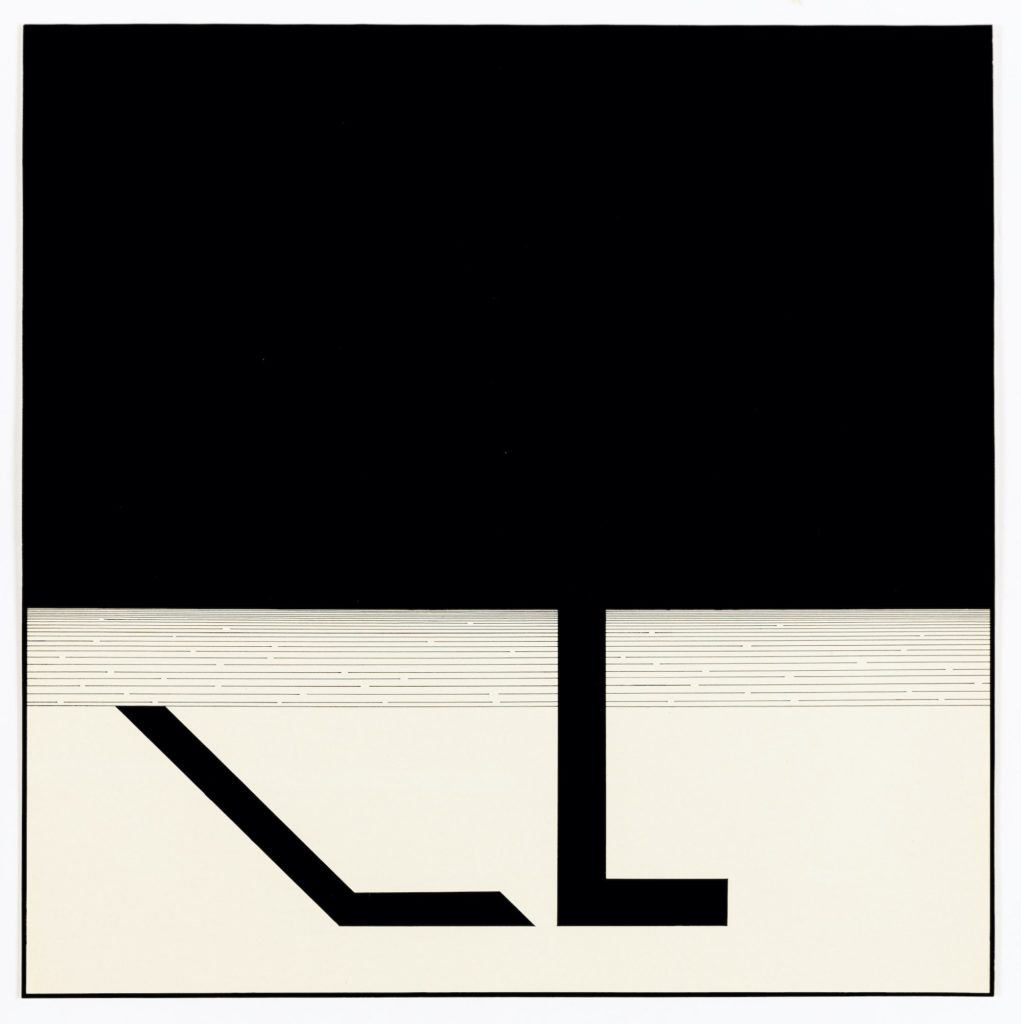Leonhard Lapin: Objects on the Beach


Two square black-and-white ink and gouache drawings from 1973 by Estonian architect and artist Leonhard Lapin show scenes from a deserted Baltic beach. On a calm white seashore, below the somewhat sinister black sky and the straight line of the horizon, stand solitary objects: two large flat L-shaped figures on the first image, one lying down on the shore and another upright, merging with the sky on the point of the skyline. We could interpret the L’s as material representations of the author’s initials. The second image shows a flight of stairs that leads to a structure or a platform which lies outside the image frame. There is no ascribed function to the objects; they could be minimalist sculptures, decorating the shore as stage sets, foundations for structures for future buildings, or industrial leftovers, the function of which we do not immediately comprehend. But perhaps to leave them undefined, would be the best way to approach them.
Lapin was born in 1947 in the southeastern Estonian town of Räpina. In 1966 he moved to study architecture at the State Art Institute in Tallinn, at the time the capital of the Soviet Republic of Estonia. During these years he also came into contact with the circle around the artist Tõnis Vint, who hosted in his small apartment regular gatherings for the exchange of information and discussion of the participants’ artworks. Lapin’s early works bear the influence of Vint’s approach, with their dominant black background, clear geometrical division of the picture plane and careful attention to the composition of the image, pertaining to autonomous values. Soon, Lapin emerged as an intellectual leader of a group of architects and artists – later named the Tallinn School – who distanced themselves from the self-sufficient disciplinary approach of the previous generation and sought an active dialogue and cooperation with other cultural fields. In architecture, this meant the erasure of its strict borders and expansion of the medium to include art, design, animation and photography; in art it signified embracing the avant-garde techniques of assemblage, collage, montage and happenings. If making architecture now included a plurality of media, artworks in turn had to display ‘architectural sensibility’ and demonstrate a desire to contribute to the production of a new living environment. In a document by Lapin and his colleagues from 1972, written a year after their graduation from the architecture department, a ‘programme for an exhibition of new architecture’, the group declared, ‘In architecture, everything is permissible.’ The text ended with an almost political call: ‘Let contemporary architecture represent a new democracy!’ [1] Signed by Lapin, Tiit Kaljundi, Vilen Künnapu, Avo-Himm Looveer and Ülevi Eljand, the manifesto took a stand against the overregulation of architectural practices and the rigidity of the rules of construction (as in the widely spread practice of mass housing), but it also saw a connection between formal experimentation and political engagement. Thus if the early 1970s have been seen in the Soviet context as a period of calming down, depoliticisation and withdrawal – in the aftermath of the Prague spring – then in the case of the artists and architects in Tallinn it was a moment that activated them and woke their interest in politics.
The interest of this group in the transforming urban and natural environment was registered during common walks, documented on photographs (mostly by Lapin’s younger colleague Jüri Okas) but also put to practice in common interventions and happenings. The wastelands and city fringes were romanticised as these artists preferred to investigate the strangeness, or even the mysteriousness, of these places. As Lapin put it in the 1980s: ‘We were drawn to slum motifs, discarded objects, the reality of the railway, warehouses and garbage heaps. Apparently it was here that the spark that ten years later burst into flames in the new architectural movement was ignited, which, leaving behind the soulless geometricism of new towns and machine-like typification, gained a strong local and irrational colouring.’ [2]
The public beach during off-season was one such fringe, featuring in several artworks and interventions by the group. On 17 September 1969 Lapin and his colleagues (including Künnapu, Andres Tolts, Ando Keskküla) organised a happening called ‘Papers in the air’ (Lapin preferred the Estonian word ‘game’) on Pirita beach in Tallinn, ‘during which they threw hundreds of newspapers and let them fly in the flurry of the autumn wind, acknowledging new kinds of relationships between the sea, the wind, the forest, the sand, the papers and oneself’. The participants ran along the shore, catching the papers and adding new ones to the storm; climbing on the beach constructions, on the structures of the children’s playground. But the long-haired artists were interrupted by local guards who interpreted the event as plain vandalism. Several of the participants were arrested for ten days. In the works of Jüri Okas, the white sandy beach near Tallinn was used as raw material for his land-art projects, later recorded on 8mm film, photographs and screenprints. In one of his photograph-based prints, Reconstruction SR from 1975, a turn-of-the-century building was sinking into the water above the horizon, while white montage marks decorated the beach below with abstract geometric figures (including also a flight of stairs). Already in 1969, Vint had produced two square black-and-white drawings showing the white beach with delicate plants and verdure below the straight horizon line of the black sky, not unlike on Lapin’s works.

It is then in between these three approaches – an activist intervention, ironic graphic montage and autonomous aesthetic withdrawal – that Lapin’s two sheets from 1973 could be placed. Although borrowing their form from Vint’s restrained aesthetics, they show objects that are somewhat absurd, perhaps even ironic, and although not directly architectural projects, we could imagine them nevertheless as proposals for new structures, providing an undefined platform or space for gatherings, spending time together, even for public dissension. At about the same time in the early 1970s Lapin engaged in a series of works on ‘machines’ (including several axonometric drawings of house-machines) and ‘architektons’, the latter inspired by Kazimir Malevich’s eponymous works that were forms on the way from art to architecture. Lapin’s architektons proposed abstract sculptural forms, sometimes including information or news media, but often without direct functional division, where the function could be invented by the user, by climbing on the structures, sitting or resting on them and looking at the surrounding environment in a different way. Or as he wrote on happenings: ‘To take a bunch of unimportant things, functionless “objects”, unimportant events and episodes … and to produce a new fantastic world, where the powerless components of the reality become an active, developing force, that would let the values of the real world seem insignificant and open up the absurdity of their coexistence.’ [3] The objects on the beach from 1973 were sculpturally less defined as architektons, but they demonstrate a similar search for these new kind of structures, seemingly ‘unimportant things’ that would allow looking at dominant values with a distance, to understand reality in new way. They also demonstrate the coexistence between a desire for an autonomy of architecture and its engagement in social processes, which became a characteristic of different participants of the Tallinn School of architects throughout the 1970s.
Notes
- Leonhard Lapin, et al, ‘Uue arhitektuuri näituse programm’, in Leonhard Lapin (ed) Arhitektuur: Kogumik ettekandeid, artikleid, vastukajasid, dokumente ja tõlkeid uuemast arhitektuurist (Tallinn: Museum of Estonian Architecture), p. 50.
- Leonhard Lapin, Ando Keskküla. Näituse kataloog (Tallinn: ENSV Riiklik kunstimuuseum, 1986), unpaginated.
- Leonhard Lapin, Häppening Eestimaal – Valimik artikleid ja ettekandeid kunstist 1967–1977. Manuscript in Leonhard Lapin’s archive (Tallinn: 1977), p. 14.
